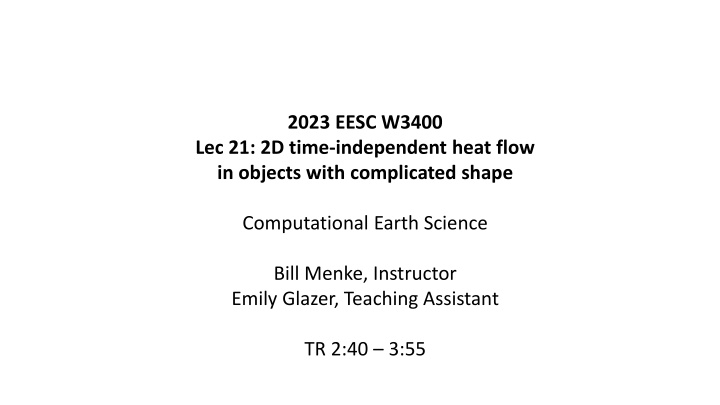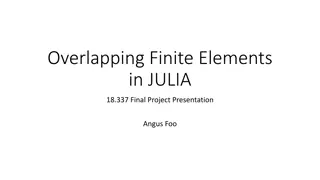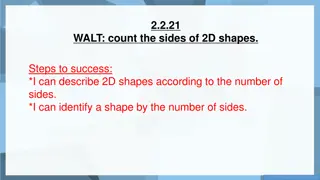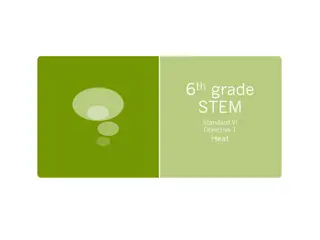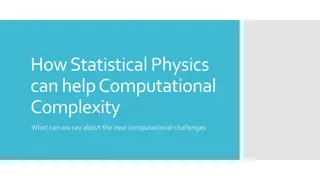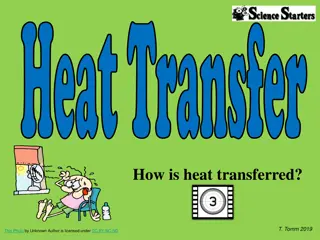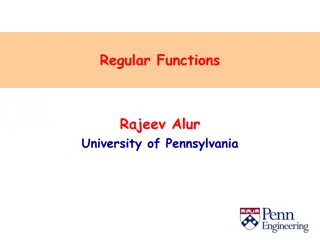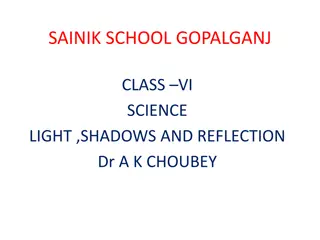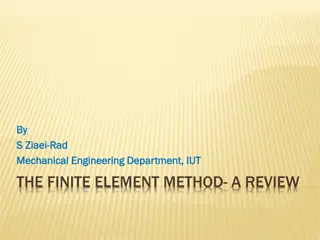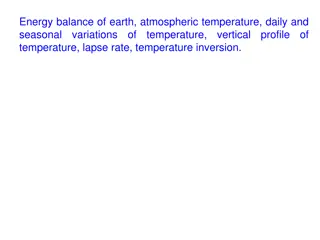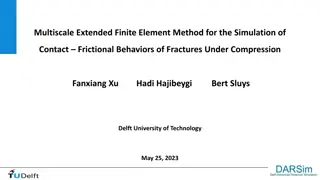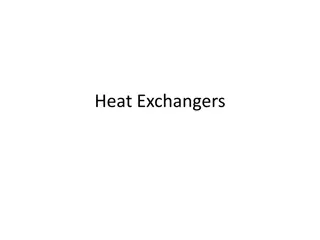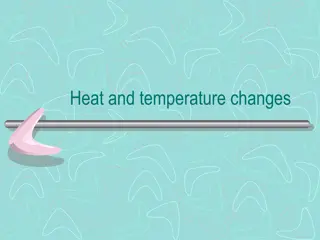Computational Earth Science: Solving Heat Flow in Objects with Complex Shapes Using Finite Difference Method
Explore projects involving the Finite Difference Method for solving static heat conduction problems, also known as the Poisson Equation. Topics include testing boundary conditions, symmetry of solutions, point sources, dipoles, and more. Gain insights into changing boundary conditions and understanding heat flow in various scenarios. Dive into the world of computational Earth science with practical hands-on applications and experimental tests.
Download Presentation

Please find below an Image/Link to download the presentation.
The content on the website is provided AS IS for your information and personal use only. It may not be sold, licensed, or shared on other websites without obtaining consent from the author.If you encounter any issues during the download, it is possible that the publisher has removed the file from their server.
You are allowed to download the files provided on this website for personal or commercial use, subject to the condition that they are used lawfully. All files are the property of their respective owners.
The content on the website is provided AS IS for your information and personal use only. It may not be sold, licensed, or shared on other websites without obtaining consent from the author.
E N D
Presentation Transcript
2023 EESC W3400 Lec 21: 2D time-independent heat flow in objects with complicated shape Computational Earth Science Bill Menke, Instructor Emily Glazer, Teaching Assistant TR 2:40 3:55
Today Projects involving Finite Difference Method for Solving Static Heat Conduction Problem a.k.a. the Poisson Equation
Today Projects involving Finite Difference Method for Solving Static Heat Conduction Problem a.k.a. the Poisson Equation ?2? ??2+?2? ??2= ?
Project A: Testing Code FDpoisson for a square grid boundary conditions given by vectors ExTop = np.zeros((Lx,1)); ExBottom = np.zeros((Lx,1)); ExLeft = np.zeros((Ly,1)); ExRight = np.zeros((Ly,1)); source given by matrix f = np.zeros((Lx,Ly));
Group A.1 Test 1. zero boundary conditions point source f[ix,iy]=something test symmetry of solution for sources placed in symmetrical positions is just this rotated 180 deg but do a few cases
Group A.1 Test 2. zero boundary conditions point source a dipole f[ix,iy]=something or f[ix,iy]=something f[ix+2,iy]=-something f[ix,iy+2]=-something test symmetry of solution for sources placed in symmetrical positions is just this rotated 180 deg but do a few cases
Group A.2 Test 1. one boundary a parabola x(1-x) or y(1-y) x s and y s in vectors x and y; elementwise multiply of two vectors np.multiply(a,b) zero source test symmetry of solution for sources placed in symmetrical positions is just this rotated 90 deg but do a few cases
Group A.3 Test 1. Change boundary conditions for top and bottom to be insulating (see next slide) left boundary condition of zero, right of 1 zero source test solution linearly increases from left to right insulating cold hot insulating
insulating boundary conditions for top and bottom insulating implies no heat flow through boundary implies ?? ?? ??= 0 on top and bottom boundaries approximate first derivative for top boundary as ?? ??= 1 ??,?+1 ??,? ? approximate first derivative for bottom boundary as ?? ??= 1 ??,? ??,? 1 ?
An element of D is set with this group of code k=kofij[some_x,some_y]; Dr[ne,0] = nr; Dc[ne,0] = k; Dv[ne,0] = 1.0; ne=ne+1;
currently, the top boundary condition implements T[ix,iy]=0 so one element of D is set k=kofij[ix,iy]; Dr[ne,0] = nr; Dc[ne,0] = k; Dv[ne,0] = 1.0; ne=ne+1; and the right-hand-side is set to the BC and the row incremented s[k,0]=ExRight[iy,0]; nr=nr+1;
now the top boundary condition will implement T[ix,iy+1]/Dx - T[ix,iy+1]/Dx = 0 so two elements of D need to be set, one for T[ix,iy+1]/Dx k=kofij[ix,iy]; Dr[ne,0] = nr; Dc[ne,0] = k; Dv[ne,0] = 1.0/Dx; ne=ne+1; and another similar code block for - T[ix,iy+1]/Dx (you figure it out) and the right-hand-side is set to zero and the row incremented s[k,0]=0.0; nr=nr+1;
Project B: Using FDPoissonWithHole for a square grid with a rectangular hole
# x location of the hole (the bold begins at ixA+1 and ends at ixB-1) ixA = 10; ixB = 20; # y location of the hole (the bold begins at iyA+1 and ends at iyB-1) iyA = 15; iyB = 32;
exterior boundary conditions given by vectors ExTop = np.zeros((met,1)); ExBottom = np.zeros((meb,1)); ExLeft = np.zeros((mel,1)); ExRight = np.zeros((mer,1)); interior boundary conditions given by vectors InTop = np.ones((mit,1)); InBottom = np.ones((mib,1)); InLeft = np.ones((mil,1)); InRight = np.ones((mir,1)); (Note different lengths, specified by met, meb, mel, etc.!) source given by matrix f = np.zeros((Lx,Ly)); (but part on boundaries and inside hole ignored!)
Scenario The material is shale and the hole is a magma conduit
Group B.1: Material is shale Interior boundary conditions T=1000 Exterior boundary conditions T=0 Shale metamorphoses at melts at T=500 square magma conduit how does the zone of contact metamorphism grow as you increase the size of the magma conduit?
Group B.2: Material is shale Interior boundary conditions T=1000 Exterior boundary conditions T=0 at top, T=300 at bottom with exterior side boundaries linearly increasing from T=0 to T=300 Shale metamorphoses at melts at T=500 square magma conduit how does the zone of contact metamorphism grow as you change the depth of the magma conduit?
